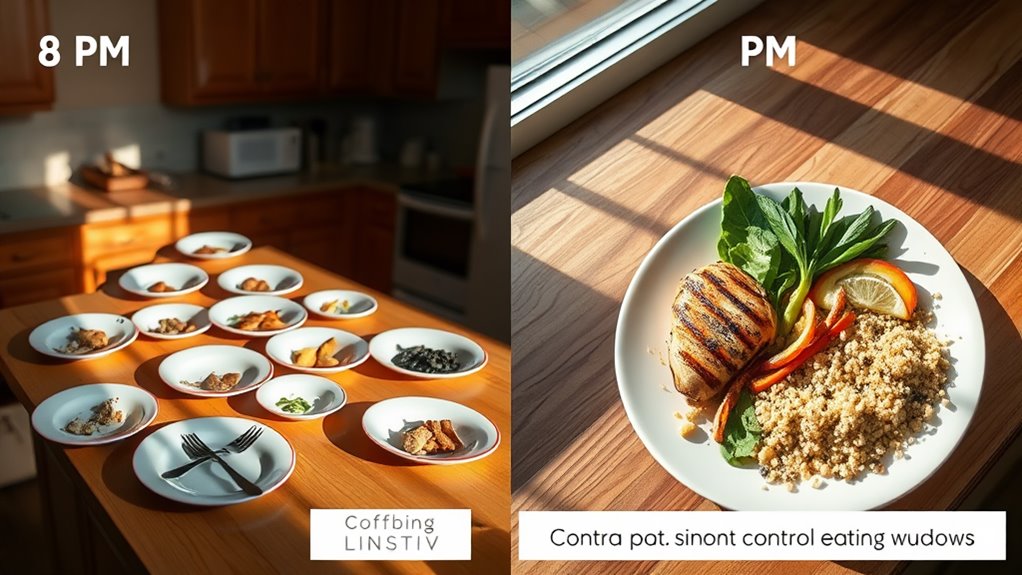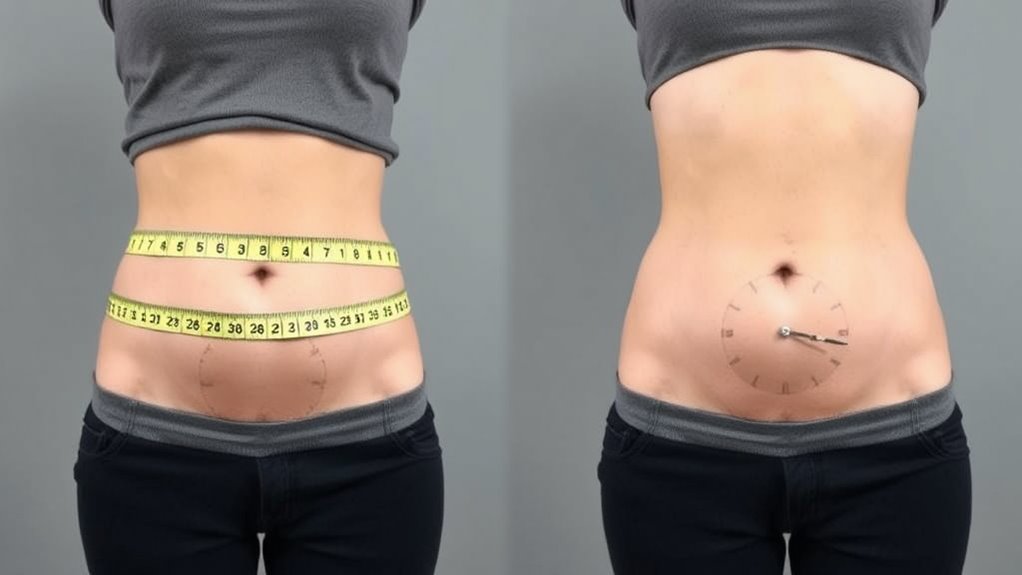Journey into how intermittent fasting targets stubborn belly fat through simple timing changes that transform your body's fat-burning potential.

Intermittent fasting can effectively reduce your belly fat by lowering insulin levels and triggering your body to burn stored fat for energy. You'll target both visceral fat (around organs) and subcutaneous fat (under skin) through various fasting methods like the 16/8 or 14/10 approaches. Research shows that fasting windows of 4-6 hours can reduce daily calorie intake by 550 calories while enhancing fat oxidation. Understanding the specific timing and methods will help optimize your fat loss results.
When it comes to understanding belly fat's impact on your health, recognizing the two distinct types is essential. Your body stores fat in two main ways: visceral fat, which surrounds your internal organs, and subcutaneous fat, which lies just beneath your skin.
While subcutaneous fat makes up about 90% of your body fat and poses fewer health risks, it's the visceral fat that you need to watch carefully. Though it only accounts for 10% of your body fat, visceral fat produces inflammatory substances called cytokines and can trigger insulin resistance. This dangerous combination increases your risk of heart disease, type 2 diabetes, and certain cancers.
You can identify subcutaneous fat by its soft, pinchable texture, but visceral fat lies deeper and can't be felt directly. This hidden fat actively affects your metabolism, blood pressure, and overall cardiovascular health, making it vital to maintain healthy levels through proper diet and exercise. It's important to note that spot exercises alone won't effectively reduce visceral fat, despite common misconceptions about targeting specific areas.

While monitoring belly fat is important, understanding how to effectively reduce it through intermittent fasting requires knowledge of the underlying biological mechanisms. When you fast, your insulin levels drop considerably, triggering your body to switch from using glucose to burning stored fat for energy. This metabolic shift typically occurs several hours after your last meal, leading to ketosis.
During fasting periods, your body undergoes vital hormonal changes that support fat loss. You'll experience decreased levels of ghrelin, which reduces hunger, while your growth hormone levels increase to preserve muscle mass. These hormonal adjustments, combined with the natural reduction in caloric intake, create an ideal environment for fat burning. The 16:8 fasting method has become particularly popular due to its effectiveness and sustainability.
Research shows that restricting your eating window to 4-6 hours can reduce your daily calorie intake by about 550 calories, resulting in approximately 3% body weight loss over 10 weeks. This process not only targets fat loss but also improves your metabolic health.
Several effective intermittent fasting methods have emerged as powerful tools for targeting stubborn belly fat. The 16/8 method restricts your eating to an 8-hour window, typically from noon to 8 PM, which helps reduce subcutaneous fat while aligning with your natural circadian rhythms. Weight loss results can vary significantly, with most people experiencing 3-8% reduction in total body weight through consistent fasting practices.
If you're looking for a different approach, the 5:2 method allows you to eat normally five days a week while limiting calories to 500-600 on two fasting days. The 14/10 method offers a more moderate option with a 10-hour eating window, specifically targeting visceral fat reduction.
Early time-restricted eating, which involves fasting from 5:30 PM until 10 AM the next day, has shown promising results for reducing abdominal fat and improving blood sugar regulation. This method works by synchronizing your food intake with your body's natural metabolic patterns, enhancing fat-burning potential.

Time-restricted eating has emerged as a powerful method for targeting belly fat through strategic meal timing. Early time-restricted eating, which involves fasting from 5:30 pm until 10 am, shows particular promise in reducing abdominal subcutaneous fat and improving blood sugar regulation.
You'll achieve peak results by following the 16/8 method, where you fast for 16 hours and eat within an 8-hour window. This approach can help you lose 1% to 4% of your body weight within several weeks. When you align your eating window with your body's natural circadian rhythms, you'll enhance metabolic efficiency and fat oxidation.
For the best outcomes, you'll want to maintain consistency with your chosen fasting schedule while ensuring it fits your lifestyle. Remember that shorter eating windows (less than 10 hours) typically prove more effective than longer ones, especially when combined with caloric restriction and regular exercise. Research shows that incorporating Mediterranean diet principles can further enhance the benefits of intermittent fasting.
When you're fasting, your body undergoes significant hormonal shifts that boost fat-burning potential, including a drop in insulin levels and an increase in growth hormone. Your metabolism adapts by shifting from using stored glycogen to burning fat for energy, typically beginning 12-18 hours into your fast. This metabolic switch activates lipolysis, breaking down your stored fat (including belly fat) into fatty acids and ketones that your body can use for fuel. During prolonged fasting, your body enters a state where amino acids are converted to provide additional energy for essential functions.
During periods of fasting, your body undergoes distinct hormonal phases that regulate metabolism and energy use. As you progress from the fed state through early fasting and into prolonged fasting, your insulin levels decrease while other hormones like growth hormone and norepinephrine increase.
Your body experiences these key hormonal changes:
These hormonal adaptations help maintain your energy levels while fasting. For women, these responses can be more pronounced due to menstrual cycle variations, potentially affecting reproductive hormones and cycle regularity. It's crucial to understand that your liver plays a central role in these metabolic adjustments through processes like gluconeogenesis. Recent research shows that women following intermittent fasting with 4-6 hour windows can achieve significant weight loss without disrupting their reproductive hormones.
The body's shift to fat burning begins approximately 12-16 hours into a fast, marking a notable metabolic adaptation. During this change, your liver depletes its glycogen stores, prompting your body to break down stored fat into free fatty acids for energy through lipolysis.
As you extend your fast beyond 16-18 hours, you'll enter ketosis, where your body produces ketones from fatty acids. This metabolic state enhances your fat-burning efficiency while preserving muscle mass. Your liver also initiates gluconeogenesis to maintain stable blood sugar levels, particularly for brain function. Throughout this process, your insulin levels decrease considerably, allowing for improved access to fat stores. This reduced insulin triggers a growth hormone release that helps protect lean tissue. Your mitochondria become more active in the citric acid cycle, leading to increased energy production from fat metabolism, particularly in the abdominal region.

Understanding your body type plays an essential role in selecting an effective intermittent fasting schedule that aligns with your metabolism and physical characteristics. While there's no definitive scientific evidence supporting fasting schedules based solely on body type, knowing your metabolic tendencies can guide your approach. Achieving optimal results requires consistent commitment to your chosen regimen.
Your success with intermittent fasting depends on finding a schedule that fits your lifestyle and metabolic needs. Consider starting with a less restrictive approach and gradually adjusting based on your body's response. Remember to maintain proper nutrition during eating windows and combine fasting with regular exercise for best results.

Successfully integrating intermittent fasting into your lifestyle requires building sustainable daily habits that support your fasting goals. Focus on consuming nutrient-dense foods during your eating windows, prioritizing lean proteins, whole grains, and healthy fats like olive oil and nuts. You'll need to stay well-hydrated by drinking plenty of water and calorie-free beverages throughout the day.
Starting with a 12-hour fasting window can help beginners adjust gradually to intermittent fasting. To maintain discipline, plan engaging activities during fasting periods to distract from hunger, and keep your meals flavorful using herbs and spices. When you're eating, choose filling foods like high-fiber vegetables and fruits to promote satiety. Exercise should be moderate, particularly on fasting days, with activities like walking or yoga helping preserve muscle mass. Track your progress regularly and adjust your approach as needed. Remember that sustainability is key – select a fasting schedule that fits naturally into your daily routine and lifestyle, making it easier to stick with long-term.

To maximize your fat loss results with intermittent fasting, you'll want to align your eating windows with your body's natural metabolic rhythm, particularly focusing on earlier caloric distribution during the day. You can optimize your fasting schedule by selecting either the 16/8 method for subcutaneous belly fat loss or the 5:2 approach if you prefer more flexibility during the week. Choose your eating windows based on when you're most active and energetic, as research shows that early time-restricted feeding (eTRF) enhances metabolic flexibility and improves your body's ability to burn fat efficiently. Studies indicate that consuming your final meal by 2 p.m. leads to better appetite control and reduced hunger hormone levels throughout the day.
Strategic selection of eating windows plays an essential role in maximizing fat loss through intermittent fasting. You'll find several evidence-based approaches that align with your lifestyle while optimizing metabolic health. The 16/8 method, which involves fasting for 16 hours, and early time-restricted feeding (eTRF) have shown promising results for reducing belly fat. Many people find success with a schedule that includes their first meal at 11am, allowing them to maintain consistent eating patterns.
To maximize results, align your eating window with daylight hours to support your circadian rhythm. This synchronization improves insulin regulation, hormone balance, and your body's ability to switch from burning carbohydrates to utilizing fat for energy.
Building on your established eating windows, enhancing meal timing can greatly boost your fat loss potential. To maximize results, schedule your meals earlier in the day, ideally between 8:00 a.m. and 2:00 p.m. This timing aligns with your body's natural circadian rhythm and enhances metabolic health.
Early time-restricted feeding (eTRF) reduces hunger hormones and improves your body's ability to burn fat for energy. Research has shown that this approach leads to lower ghrelin levels in participants. You'll experience better blood sugar regulation and reduced insulin levels, which helps your cells access stored fat. This approach naturally leads to consuming fewer calories while maintaining steady energy levels throughout the day.
For ideal performance, coordinate your eating schedule with your daily activities and exercise routine. You'll find that an 18-hour fasting period can considerably improve your body's fat-burning capacity while supporting your overall metabolic function.

While intermittent fasting can be an effective approach for reducing belly fat, practitioners often face several significant challenges during their fasting journey. You'll likely encounter physical side effects, including headaches, fatigue, and digestive issues, especially during the initial adaptation period. Mental challenges such as mood swings and increased stress levels can also impact your fasting experience. Research shows that long-term safety of intermittent fasting remains unproven for humans.
To overcome these obstacles and maintain a sustainable fasting practice, consider implementing these evidence-based solutions:
If you experience severe side effects or have a history of eating disorders, it's essential to consult with a healthcare provider before starting or continuing intermittent fasting. With proper planning and attention to your body's signals, you can effectively manage these challenges while working toward your belly fat reduction goals.

Beyond reducing belly fat, you'll find that intermittent fasting markedly improves key markers of heart health, including blood pressure and resting heart rates. Your metabolic function will likely enhance through improved insulin sensitivity and reduced fasting glucose levels, which are essential for managing and preventing type 2 diabetes. These cardiovascular and metabolic improvements work together to reduce your overall risk of developing metabolic syndrome and heart disease. During fasting periods, your body undergoes metabolic switching as it transitions from using glucose to burning stored fat for energy.
Although intermittent fasting's primary appeal lies in weight management, research reveals its significant impact on heart health markers. Clinical trials demonstrate that time-restricted eating can substantially improve your cardiovascular health through multiple pathways. The TIMET study and other research have shown that intermittent fasting increases galectin-3, a protein that helps control inflammation and protect your heart. Studies suggest that following a 24-hour fasting period twice weekly, followed by once weekly maintenance, can produce meaningful cardiovascular benefits.
Key cardiovascular improvements include:
It's important to note that while these benefits are promising, you'll need to consult your healthcare provider before starting intermittent fasting, especially if you have pre-existing heart conditions, diabetes, or kidney disease. Recent studies suggest that extremely restrictive eating windows might pose cardiovascular risks.
The metabolic benefits of intermittent fasting extend far beyond cardiovascular improvements, with research highlighting its powerful effects on circadian biology and cellular function. When you restrict your eating window to 8-10 hours daily, you're synchronizing your body's natural rhythms with its metabolic processes, optimizing how you process nutrients throughout the day. Studies indicate that alternate day fasting can significantly improve plasma lipid profiles and overall metabolic health.
During fasting periods, your body undergoes significant metabolic shifts, switching from glucose to fat as its primary energy source. This change is accompanied by beneficial hormonal changes, including increased human growth hormone levels. You'll also experience enhanced insulin sensitivity and improved glucose metabolism. The effects are amplified through positive changes in your gut microbiome, which plays an essential role in metabolic health through improved nutrient absorption and reduced inflammation.
You can drink black coffee and unsweetened tea during fasting, as they're low in calories. Keep them plain without milk or sugar to maintain your fast's metabolic benefits.
Most pills won't break your fast, but liquid, chewable, or gummy medications might contain sugar. You'll need to consult your doctor about timing and whether specific medications require food.
Light to moderate exercise is safe while fasting, but you'll want to avoid high-intensity workouts. Stay hydrated, listen to your body, and stop if you feel dizzy or unwell.
You shouldn't practice strict intermittent fasting while breastfeeding. If you're past 6 months postpartum, you can try gentle time-restricted eating (14/10), maintaining at least 1800 calories daily.
Yes, your sleeping hours absolutely count toward fasting time! When you're sleeping, your body's already in a natural fasting state, making those 7-9 hours a perfect addition to your fasting window.
Intermittent fasting can revolutionize your battle against stubborn belly fat, offering you a mountain of metabolic benefits when practiced consistently. You'll find that combining time-restricted eating with proper nutrition amplifies your body's natural fat-burning mechanisms. While it's not a magic solution, the research clearly demonstrates that strategic fasting periods can help you achieve meaningful reductions in visceral fat and improve your overall metabolic health.